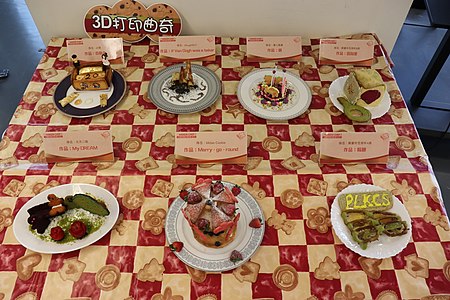3D Printing/Materials
Plastics
[edit | edit source]
FFF 3D printers typically accept a filament of a certain diameter.
Some FFF 3D printers are modified to use pellets for ease of using recycled material.[1]
PLA
[edit | edit source]PLA is a common 3D printing material. It's inexpensive and easy to use, making it a good choice as a starter material for beginners, and a general material for more advanced operators.[2]
Compared to using ABS, a typical FFF printer using PLA should emit less particles.[3]
ABS
[edit | edit source]
ABS is cheap and strong but needs the right environment to print well.[4]
Compared to using PLA, a typical FFF printer using ABS should emit more particles.[3][5] Ventilation should be used when printing ABS.[4]
HIPS
[edit | edit source]HIPS is a good starting material due to its ease of use and because it is not expensive.[6]
PETG
[edit | edit source]PETG prints are externally similar to ABS prints despite their different chemical makeup. PETG is less volatile than ABS, remaining stable under a wider range of printing environments.[2]
PETG can't be directly printed on a glass bed.[2] An intermediate material like tape must be used.[7]
Nylon
[edit | edit source]
Nylon 3D prints are known for being somewhat flexible and durable.[7][8]
Nylon can also be dyed to produce different color materials.[7]
Nylon can be temperamental and difficult to work with.[4]
Flexible
[edit | edit source]Flexible filaments are expensive to buy and temperamental to use, but gives prints unique properties, allowing them to deform slightly.[2] These filaments tend to jam, and are best used on direct drive printers.[4]
Ideal Support Materials
[edit | edit source]
PVA
[edit | edit source]PVA is water soluble, so PVA material melts in water while leaving the primary plastic intact.[4] This makes it ideal for support material when used in a dual extruder or a multi material printer, since supports can be dissolved instead of manually removed.
Composite Materials
[edit | edit source]Composite materials mix a printable material with a material that typically can't be printed, giving it unique properties, as well as unique challenges.
Composite Examples
[edit | edit source]- Magnetic Iron PLA - Can attract strong magnets and rust.[9][10]
- Conductive PLA - Prints are electrically conductive and can carry small currents for simple electronics or to enable parts to trigger touchscreens.[11]
Resins
[edit | edit source]SLA printers use liquid resin, instead of filaments.
These resins can usually be colored with dye.[12][13]
Exotic Materials
[edit | edit source]3D printers geared towards directly printing in exotic materials exist.[14][15]
It is often a better idea to try 3D printing a mold in a conventional material and then using that mold to make the end product.[16][17]
3D printing food in particular has unique challenges, as the food must be printed in a way that avoids contamination and is safe to eat.[18]
-
3D printed jewelry.
-
3D printed cookies.
-
A 3D Printed sugar cube.
Material Storage
[edit | edit source]When possible FFF filaments should be kept in a drybox to avoid contamination of material from humidity and dust.[21] If this is impractical, a dust filter can also be used on the filament feed.[22]
References
[edit | edit source]- ↑ "10 Tips for Converting a 3D Printer to Pellet Extrusion | Make:". Make: DIY Projects and Ideas for Makers. 25 November 2020. Retrieved 30 November 2020.
- ↑ a b c d "3D Printer Filaments: Definitions, Applications, and Tips". Retrieved 6 November 2020.
- ↑ a b "3D Printer Safety – Environment, Health, and Safety". Retrieved 6 November 2020.
- ↑ a b c d e White, Lindsay. "Materials for 3D Printing – build IT @SDSU Library". Retrieved 6 November 2020.
{{cite web}}: Missing|author1=(help) - ↑ "Particles Emitted by Consumer 3D Printers Could Hurt Indoor Air Quality". www.news.gatech.edu. Retrieved 6 November 2020.
- ↑ "Printing Materials – Innovation Studio". Retrieved 6 November 2020.
- ↑ a b c "Closing the Loop On 3D Printing". UCSF Library. 30 November 2017. Retrieved 29 November 2020.
- ↑ Meher, Robin. "Library Guides: 3D Printing at the Library of Engineering and Science: Filament Guide". guides.lib.purdue.edu. Retrieved 29 November 2020.
- ↑ "Magnetic Iron PLA Magnetic 3D Printer Filament". LulzBot. 18 September 2015. Retrieved 6 November 2020.
- ↑ "Iron-filled Metal Composite PLA". ProtoPlant, makers of Proto-pasta. Retrieved 6 November 2020.
- ↑ "Conductive PLA". LulzBot. 18 September 2015. Retrieved 6 November 2020.
- ↑ "Color Kit". Formlabs. Retrieved 30 November 2020.
- ↑ "How Do I Dye Resin 3D Prints? - Easy To Create Custom Colored Resin". 3D Printed Miniatures for Gaming or Display. 31 January 2020. Retrieved 30 November 2020.
- ↑ "CES 2014: 3D food printers create sweets and chocolates". BBC News. 8 January 2014. Retrieved 6 November 2020.
- ↑ "Engineers Create A Titanium Rib Cage Worthy Of Wolverine". NPR.org. Retrieved 6 November 2020.
- ↑ Says, Jobfor778 (7 February 2020). "The beginner's guide to mold making and casting". Prusa Printers. Retrieved 6 November 2020.
- ↑ "Casting Metal Parts And Silicone Molds From 3D Prints". Hackaday. 25 February 2018. Retrieved 6 November 2020.
- ↑ "Maker Faire NY: Cocoa Press Chocolate Printer". Hackaday. 29 September 2018. Retrieved 6 November 2020.
- ↑ Mishan, Ligaya (21 February 2019). "The Secret Ingredient for These Desserts: A 3-D Printer (Published 2019)". The New York Times. Retrieved 29 November 2020.
- ↑ "NASA's 3D Food Printer Will Make Pizza at Amusement Parks". www.vice.com. Retrieved 29 November 2020.
- ↑ "Filament dryboxes and alternative spool holders - not only for MMU2S". Prusa Printers. 26 July 2019. Retrieved 6 November 2020.
- ↑ "Filament Dust Filter Helps Keep Your Print Quality High". Hackaday. 6 September 2020. Retrieved 6 November 2020.



